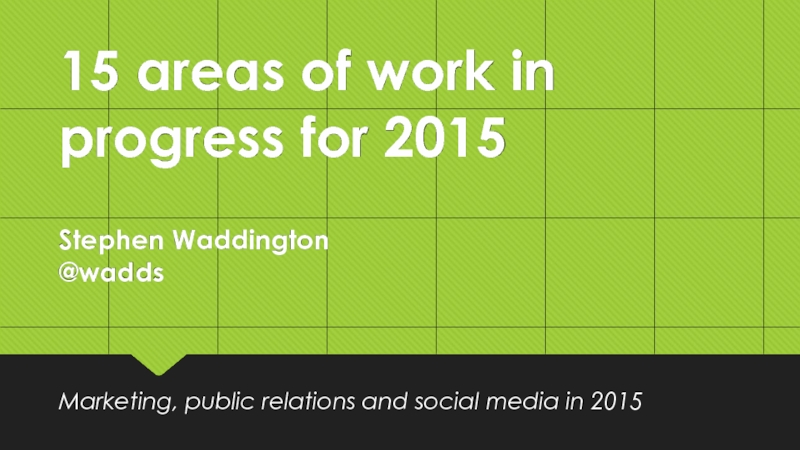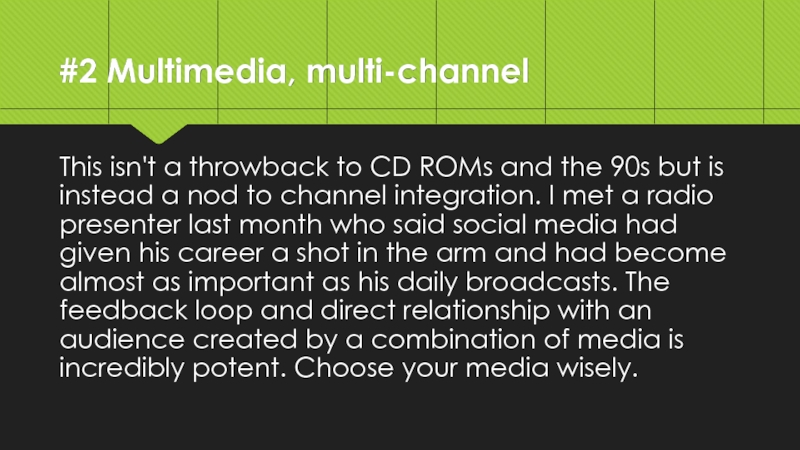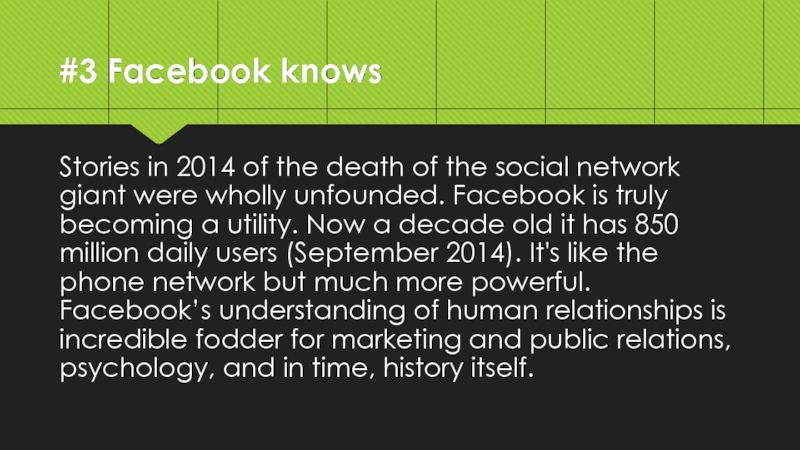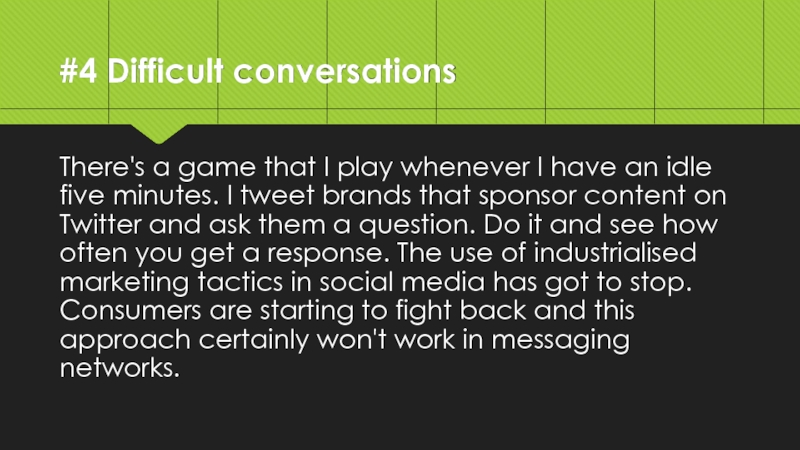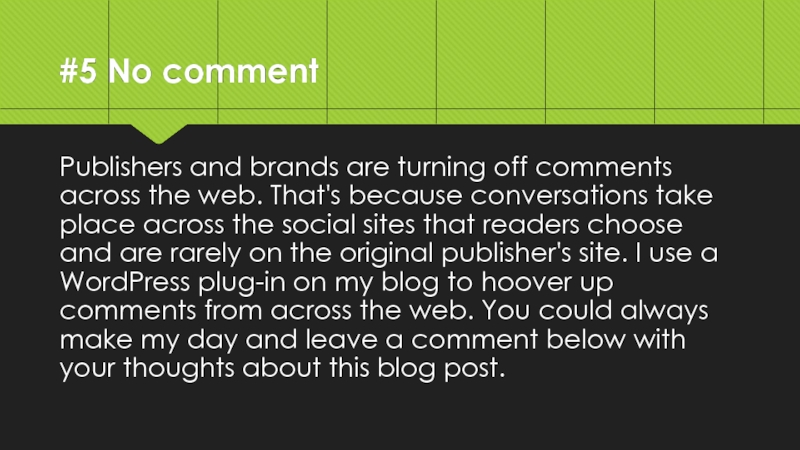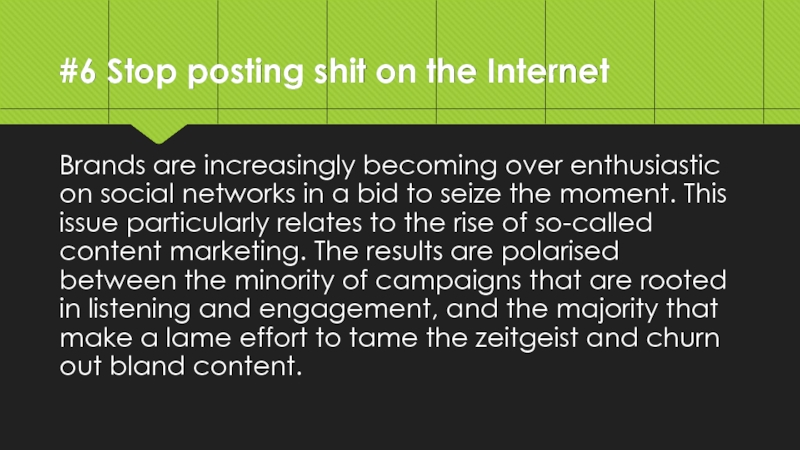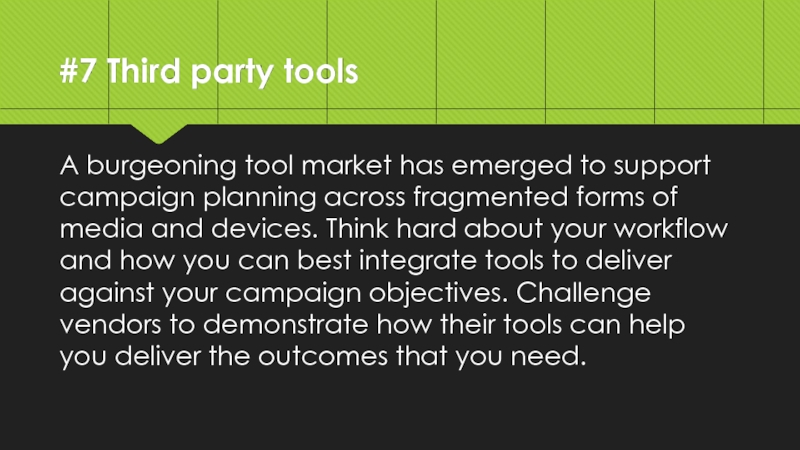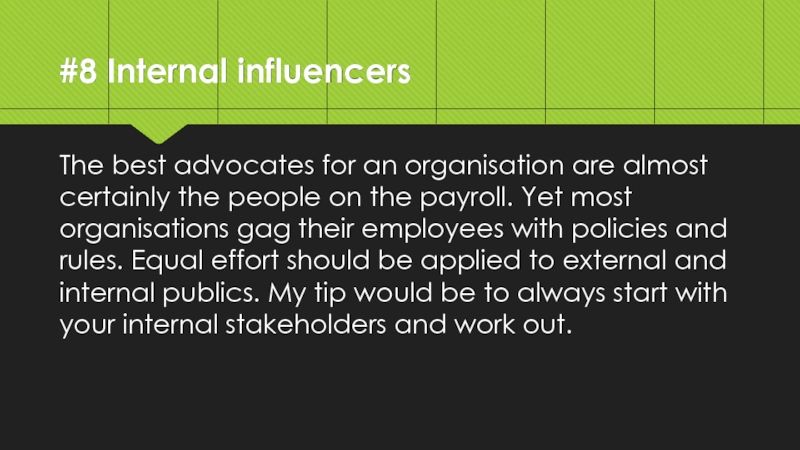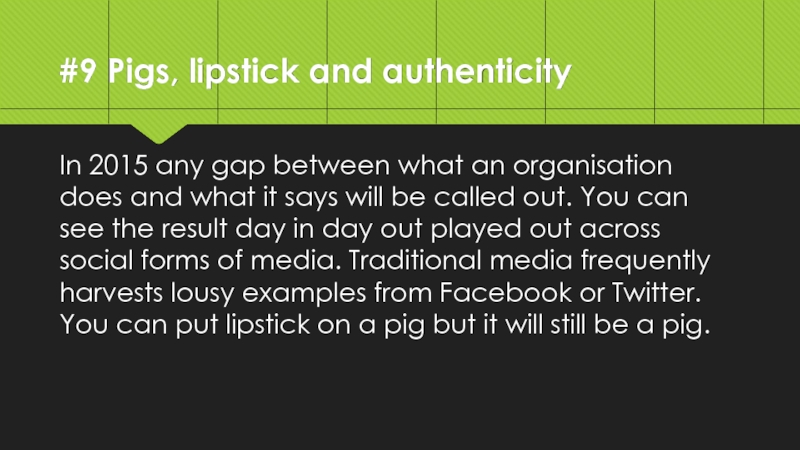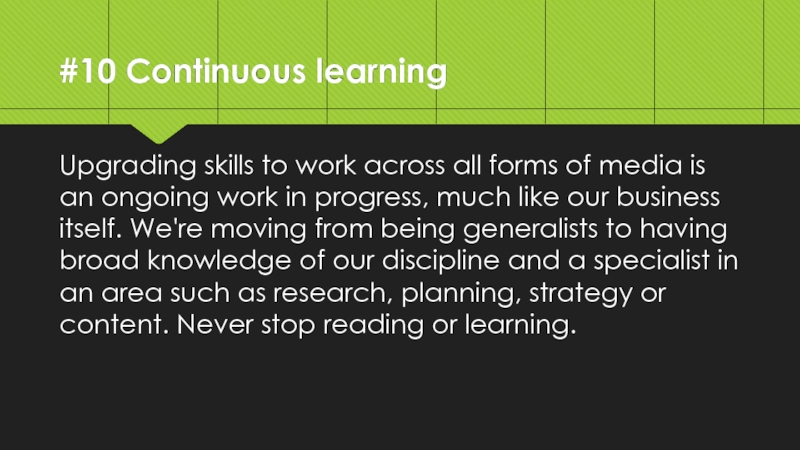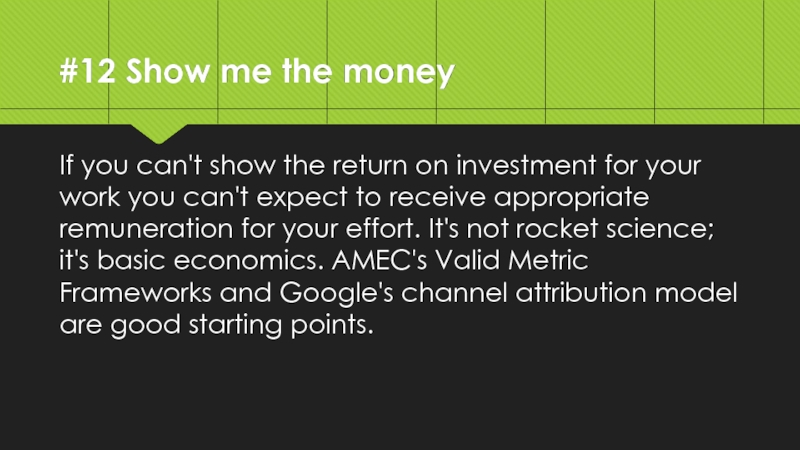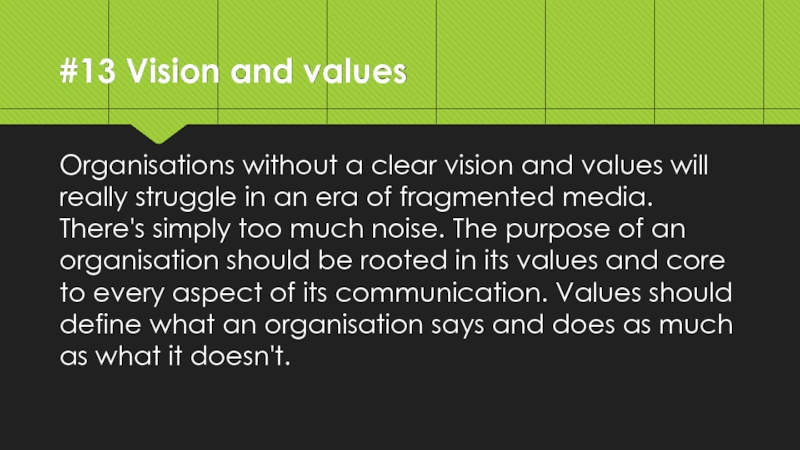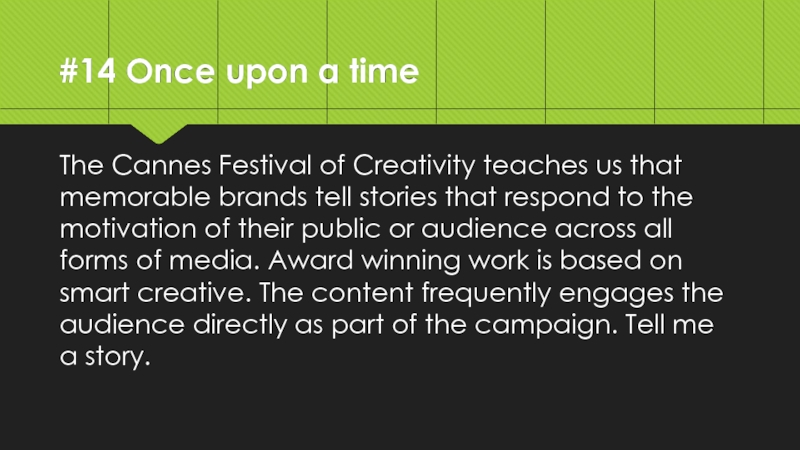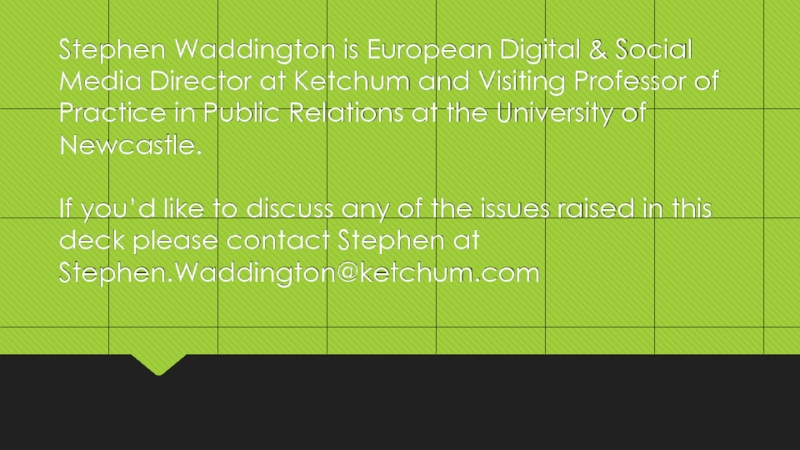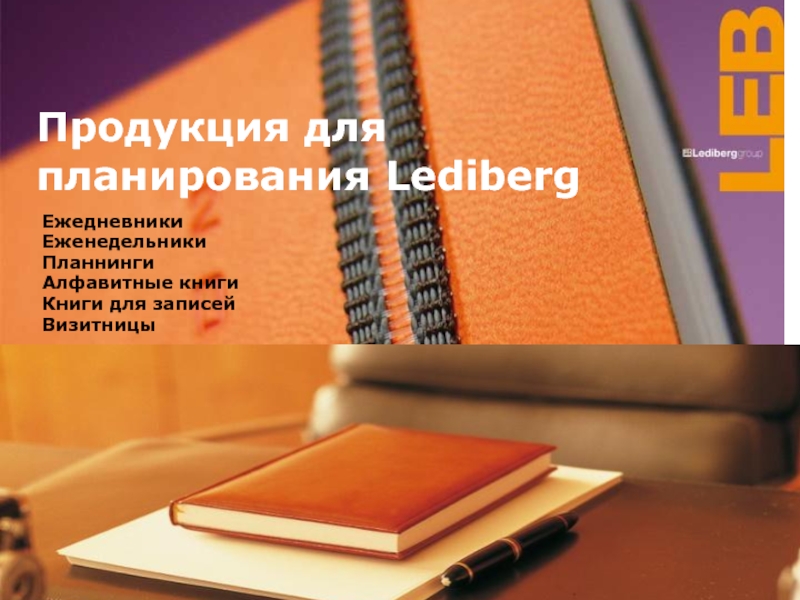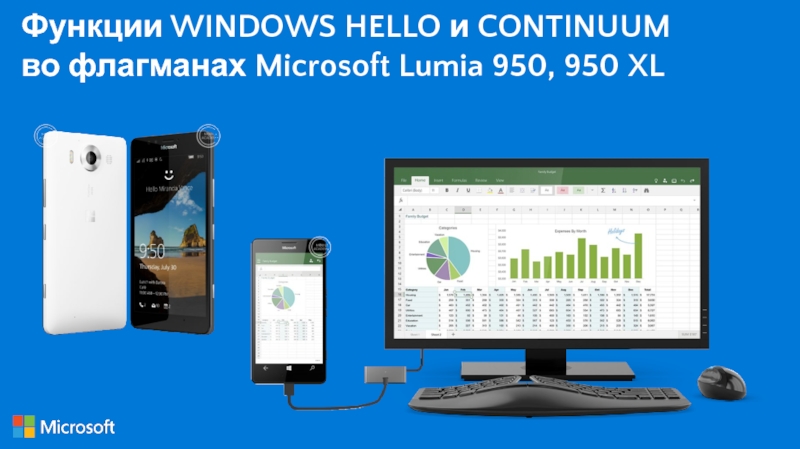and social media in 2015
- Главная
- Разное
- Дизайн
- Бизнес и предпринимательство
- Аналитика
- Образование
- Развлечения
- Красота и здоровье
- Финансы
- Государство
- Путешествия
- Спорт
- Недвижимость
- Армия
- Графика
- Культурология
- Еда и кулинария
- Лингвистика
- Английский язык
- Астрономия
- Алгебра
- Биология
- География
- Детские презентации
- Информатика
- История
- Литература
- Маркетинг
- Математика
- Медицина
- Менеджмент
- Музыка
- МХК
- Немецкий язык
- ОБЖ
- Обществознание
- Окружающий мир
- Педагогика
- Русский язык
- Технология
- Физика
- Философия
- Химия
- Шаблоны, картинки для презентаций
- Экология
- Экономика
- Юриспруденция
15 areas of work in progress for 2015Stephen Waddington@wadds презентация
Содержание
- 1. 15 areas of work in progress for 2015Stephen Waddington@wadds
- 2. #1 Demise of demographics Traditional marketing models
- 3. #2 Multimedia, multi-channel This isn't a throwback
- 4. #3 Facebook knows Stories in 2014 of
- 5. #4 Difficult conversations There's a game that
- 6. #5 No comment Publishers and brands are
- 7. #6 Stop posting shit on the Internet
- 8. #7 Third party tools A burgeoning tool
- 9. #8 Internal influencers The best advocates for
- 10. #9 Pigs, lipstick and authenticity In 2015
- 11. #10 Continuous learning Upgrading skills to work
- 12. #11 End of the line The future
- 13. #12 Show me the money If you
- 14. #13 Vision and values Organisations without a
- 15. #14 Once upon a time The Cannes
- 16. #15 Higher purpose Public relations increasingly has
- 17. Stephen Waddington is European Digital & Social
Слайд 2#1 Demise of demographics
Traditional marketing models based on age, gender, location
and income no longer work. Marketing segmentation was never that simple but in 2015 social media subvert all norms and hierarchies. Listen, and I mean really listen, and then let's have a conversation based on what I say, and more importantly, what I do.
Слайд 3#2 Multimedia, multi-channel
This isn't a throwback to CD ROMs and the
90s but is instead a nod to channel integration. I met a radio presenter last month who said social media had given his career a shot in the arm and had become almost as important as his daily broadcasts. The feedback loop and direct relationship with an audience created by a combination of media is incredibly potent. Choose your media wisely.
Слайд 4#3 Facebook knows
Stories in 2014 of the death of the social
network giant were wholly unfounded. Facebook is truly becoming a utility. Now a decade old it has 850 million daily users (September 2014). It's like the phone network but much more powerful. Facebook’s understanding of human relationships is incredible fodder for marketing and public relations, psychology, and in time, history itself.
Слайд 5#4 Difficult conversations
There's a game that I play whenever I have
an idle five minutes. I tweet brands that sponsor content on Twitter and ask them a question. Do it and see how often you get a response. The use of industrialised marketing tactics in social media has got to stop. Consumers are starting to fight back and this approach certainly won't work in messaging networks.
Слайд 6#5 No comment
Publishers and brands are turning off comments across the
web. That's because conversations take place across the social sites that readers choose and are rarely on the original publisher's site. I use a WordPress plug-in on my blog to hoover up comments from across the web. You could always make my day and leave a comment below with your thoughts about this blog post.
Слайд 7#6 Stop posting shit on the Internet
Brands are increasingly becoming over
enthusiastic on social networks in a bid to seize the moment. This issue particularly relates to the rise of so-called content marketing. The results are polarised between the minority of campaigns that are rooted in listening and engagement, and the majority that make a lame effort to tame the zeitgeist and churn out bland content.
Слайд 8#7 Third party tools
A burgeoning tool market has emerged to support
campaign planning across fragmented forms of media and devices. Think hard about your workflow and how you can best integrate tools to deliver against your campaign objectives. Challenge vendors to demonstrate how their tools can help you deliver the outcomes that you need.
Слайд 9#8 Internal influencers
The best advocates for an organisation are almost certainly
the people on the payroll. Yet most organisations gag their employees with policies and rules. Equal effort should be applied to external and internal publics. My tip would be to always start with your internal stakeholders and work out.
Слайд 10#9 Pigs, lipstick and authenticity
In 2015 any gap between what an
organisation does and what it says will be called out. You can see the result day in day out played out across social forms of media. Traditional media frequently harvests lousy examples from Facebook or Twitter. You can put lipstick on a pig but it will still be a pig.
Слайд 11#10 Continuous learning
Upgrading skills to work across all forms of media
is an ongoing work in progress, much like our business itself. We're moving from being generalists to having broad knowledge of our discipline and a specialist in an area such as research, planning, strategy or content. Never stop reading or learning.
Слайд 12#11 End of the line
The future of the media remains a
work in progress. Publishers and networks are all trying to figure out how to develop sustainable business models. In order to optimise campaign investment, paid media may need to be integrated into earned campaigns and earned media into paid campaigns. Public relations practitioners need to get over the fact that sometimes you simply have to pay for it.
Слайд 13#12 Show me the money
If you can't show the return on
investment for your work you can't expect to receive appropriate remuneration for your effort. It's not rocket science; it's basic economics. AMEC's Valid Metric Frameworks and Google's channel attribution model are good starting points.
Слайд 14#13 Vision and values
Organisations without a clear vision and values will
really struggle in an era of fragmented media. There's simply too much noise. The purpose of an organisation should be rooted in its values and core to every aspect of its communication. Values should define what an organisation says and does as much as what it doesn't.
Слайд 15#14 Once upon a time
The Cannes Festival of Creativity teaches us
that memorable brands tell stories that respond to the motivation of their public or audience across all forms of media. Award winning work is based on smart creative. The content frequently engages the audience directly as part of the campaign. Tell me a story.
Слайд 16#15 Higher purpose
Public relations increasingly has a role in every area
of an organisation. It's shifting from the communication department to human resources, customer service, sales and product development. It is the ears, eyes and mouth of an organisation, and increasingly the conscience.
Слайд 17Stephen Waddington is European Digital & Social Media Director at Ketchum and Visiting
Professor of Practice in Public Relations at the University of Newcastle.
If you’d like to discuss any of the issues raised in this deck please contact Stephen at Stephen.Waddington@ketchum.com
